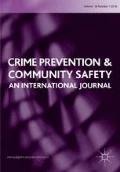Abstract
This exploratory paper delves into differences and similarities in the rated seriousness of offences suffered by victims of different national origins. The issue is important because a mismatch between police and victim assessments of seriousness is likely to fuel discord. It was found that first-generation immigrants did not differ in their rating of the seriousness of offences against the person from either the indigenous population or according to region of birth. However, those of Asian origin rated vehicle and property crime they had suffered as more serious than did other groups about crimes they suffered. The anticipated higher seriousness rating of offences reported to the police was observed for all groups. People of Asian origin reported to the police a smaller proportion of offences they rated trivial than did people in other groups. Analysis of seriousness judgements in victimization surveys represents a much-underused resource for understanding the nexus between public perceptions and criminal justice responses.





Similar content being viewed by others
Notes
Gender, age, race, influence of alcohol, influence of drugs, possession of a weapon, affiliation to a gang.
Vehicle parts, money/wallet/purse/credit card, mobile phone, jewellery, clothes, documents, electrical goods, computer, CDs/games, house keys, car keys, tools, bicycle/parts, garden furniture, bins, bag/briefcase, purse/wallet, cash, cigarettes/food.
Vehicle, valuables, electrical goods, speakers, mobile phone, tools, bicycle/parts, camera, CDs/games, household items, house keys, car keys, exterior fittings, garden furniture.
Minor bruising/black eye, severe bruising, scratches, cuts, broken bones, broken nose, chipped teeth, concussion/loss of consciousness, facial/head injuries.
References
Akman, D.D., A. Normandeau, and S. Turner. 1967. The measurement of delinquency in Canada. Journal of Criminal Law, Criminology and Police Science 58: 330–337.
Hebenton, B., D. Shaw, and K. Pease. 2009. Offences involving indecent photographs and Pse do-photographs of children: An analysis of sentencing guidelines. Psychology, Crime and Law 15: 425–440.
Herzog, S., and T. Einat. 2016. Moral judgment, crime seriousness, and the relations between them: An exploratory study. Crime & Delinquency 62 (4): 470–500.
Ignatans, D., and K. Pease. 2015. Taking crime seriously: Playing the weighting game. Poli cing: a Journal of Policy and Practice, pav029.
Pease, K., J. Ireson, and J. Thorpe. 1975. Modified crime indices for eight countries. Journal of Criminal Law and Criminology 56: 209–220.
Pease, K. 1985. Judgements of crime seriousness: Findings from the 1984 British Crime Survey. Research and Planning Unit Paper 44. London: Home Office.
Ranyard, R., B.I.L.L. Hebenton, and K. Pease. 1994. An analysis of a guideline case as applied to the offence of rape. Howard Journal of Criminal Justice 33: 203–217.
Rossi, P., E. Waite, C. Bose, and R. Berk. 1974. The seriousness of crimes: Normative structure and individual differences. American Sociological Review 39: 224–237.
Sellin, T., and M.E. Wolfgang. 1964. The measurement of delinquency. New York: Wiley.
Sherman, L.W., P.W. Neyroud, and E.C. Neyroud. 2014. The Cambridge Crime Harm Index (CHI) measuring total harm from crime based on sentencing guidelines, Version 2.0. Cambridge: University of Cambridge.
Thurstone, L. 1927. The method of paired comparisons for social values. Journal of Abnormal and Social Psychology 21: 384–400.
Velez-Diaz, A., and M. Megargee. 1970. An investigation of differences in value judgements between youthful offenders in Puerto Rico. Journal of Criminal Law, Criminology and Police Science 61: 549–553.
Wagner, H., and K. Pease. 1978. On adding up scores of offence seriousness. British Journal of Criminology 18: 175–178.
Acknowledgements
This paper is associated with a British Academy grant SG151882.
Author information
Authors and Affiliations
Corresponding author
Rights and permissions
About this article
Cite this article
Los, G., Ignatans, D. & Pease, K. First-generation immigrant judgements of offence seriousness: evidence from the crime survey for England and Wales. Crime Prev Community Saf 19, 151–161 (2017). https://doi.org/10.1057/s41300-017-0019-2
Published:
Issue Date:
DOI: https://doi.org/10.1057/s41300-017-0019-2




